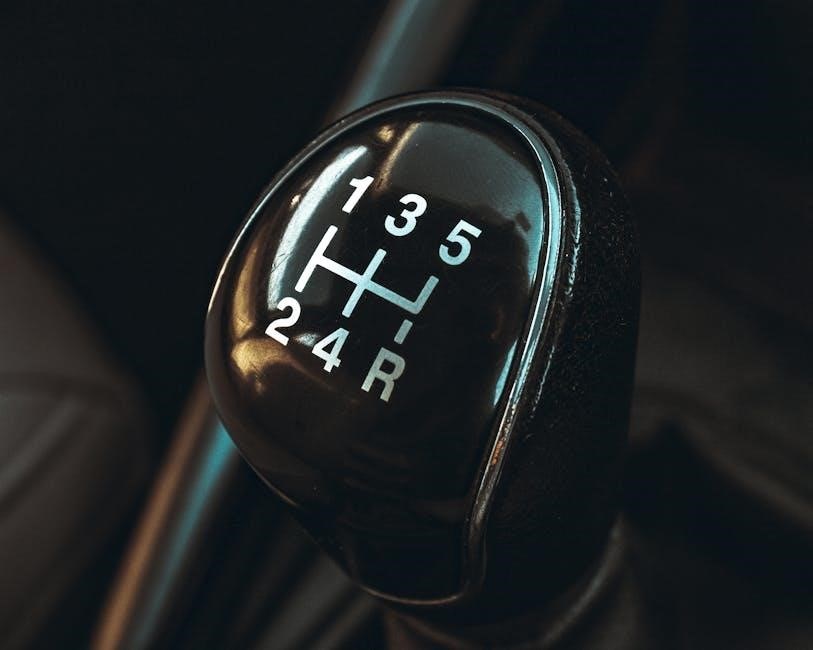The Safety 1st Grow and Go 3-in-1 Car Seat offers versatility, supporting children from 5 to 100 pounds․ Designed for rear-facing, forward-facing, and booster modes, it ensures long-term safety and comfort․ With a sturdy build and easy adjustments, it adapts to your child’s growth․ Reading the manual is crucial for proper installation and use, ensuring your child’s safety․ This seat combines practicality with advanced safety features, making it a reliable choice for parents seeking convenience and protection․
1․1 Overview of the Safety 1st Grow and Go Car Seat
The Safety 1st Grow and Go 3-in-1 Car Seat is a versatile and durable child restraint designed to accommodate children from 5 to 100 pounds․ It transitions seamlessly through three modes: rear-facing, forward-facing, and booster, ensuring long-term use as your child grows․ Built with safety and comfort in mind, the seat features a sturdy construction and easy-to-adjust components․ Its design allows for a secure fit in various vehicles, while the included manual provides detailed guidance for proper installation and use․ The Grow and Go model emphasizes adaptability, making it a practical choice for families seeking a car seat that evolves with their child’s needs․ Reading the manual is essential to maximize safety and convenience․

1․2 Importance of Reading the Manual
Reading the Safety 1st Grow and Go 3-in-1 Car Seat manual is crucial for ensuring proper installation, use, and safety․ Failure to follow the instructions can lead to serious safety risks, as highlighted in the provided information․ The manual provides detailed guidance on weight limits (5-100 pounds), mode transitions, and installation methods, including LATCH and seatbelt options․ It also includes warnings and precautions to avoid improper use․ Additionally, the manual offers troubleshooting tips and maintenance advice to extend the seat’s lifespan․ QR codes are included for access to installation videos, catering to different learning preferences․ Ignoring the manual may result in incorrect belt fit in booster mode or installation difficulties, as noted in reviews․ Always keep the manual for future reference to ensure your child’s safety and convenience․

Key Features and Benefits
The Safety 1st Grow and Go 3-in-1 Car Seat offers 3-in-1 functionality, supporting rear-facing, forward-facing, and booster modes․ It accommodates children from 5 to 100 pounds, ensuring long-term use․ Built-in safety features and a sturdy design provide reliable protection․ The seat also prioritizes comfort with adjustable settings, making it a practical and convenient choice for growing children․
2․1 3-in-1 Functionality: Rear-Facing, Forward-Facing, and Booster Modes
The Safety 1st Grow and Go 3-in-1 Car Seat is designed to adapt to your child’s growth, offering three distinct modes: rear-facing, forward-facing, and booster․ Rear-facing mode is ideal for infants, providing enhanced protection for their delicate neck and spine․ As your child grows, the seat transitions to forward-facing mode, suitable for toddlers who outgrow the rear-facing position․ Finally, the booster mode accommodates older children, ensuring proper seatbelt fit until they no longer need a car seat․ This versatility allows the seat to be used from 5 to 100 pounds, making it a long-lasting solution for families․ The seamless transition between modes ensures your child remains safe and comfortable as they grow․
2․2 Weight and Height Limits (5-100 Pounds)
The Safety 1st Grow and Go 3-in-1 Car Seat accommodates children weighing between 5 and 100 pounds, ensuring long-term use as your child grows․ Rear-facing mode is designed for infants weighing 5-40 pounds, while forward-facing mode supports children from 22-65 pounds․ The booster mode is intended for older children weighing between 40-100 pounds․ These weight limits ensure proper fit and safety across all stages․ Always refer to the manual to confirm the appropriate mode for your child’s weight and height․ Adhering to these limits is crucial for optimal protection and to meet federal safety standards․ This wide range makes the seat a practical investment for families, providing safety and comfort from infancy through early childhood․ Proper use within these limits ensures your child is protected at every stage of their growth․
2․3 Built-in Safety Features
The Safety 1st Grow and Go 3-in-1 Car Seat is equipped with advanced safety features to protect your child in various scenarios․ It includes a robust shell designed to absorb impact forces, ensuring maximum protection during collisions․ The seat also features side impact protection, which cushions your child from the effects of side collisions․ Additionally, the seatbelt and LATCH system provide secure installation options, minimizing movement and ensuring a snug fit in your vehicle․ These built-in features work together to create a safe environment for your child, offering peace of mind for parents․ Regular checks and adherence to the manual’s guidelines are essential to maintain the effectiveness of these safety features․ By integrating these technologies, the car seat meets rigorous safety standards, making it a reliable choice for protecting your child on the road․
2․4 Comfort and Convenience
The Safety 1st Grow and Go 3-in-1 Car Seat prioritizes comfort and convenience, ensuring a pleasant ride for your child․ It features a padded seat and adjustable headrest, providing support as your child grows․ The seat is designed with removable and washable covers, making maintenance easy․ Additionally, the seat’s lightweight design and compact footprint allow for effortless transitions between vehicles․ The built-in cup holders add convenience, keeping snacks and drinks within reach․ The manual emphasizes proper adjustments to ensure a comfortable fit in all modes․ With its ergonomic design and user-friendly features, this car seat offers a practical solution for busy parents while keeping their child comfortable and secure․ These features make it a versatile and convenient option for daily use․

Installation Instructions
Install using LATCH or seatbelt, following manual guidelines․ For vehicles without a back seat, consult your vehicle’s manual․ QR code provides video assistance for clarity and ease․
3․1 LATCH System Installation
The Safety 1st Grow and Go 3-in-1 Car Seat can be installed using the LATCH (Lower Anchors and Tethers for Children) system, which provides a secure and straightforward setup․ Locate the LATCH anchors in your vehicle, typically found in the rear seat․ Attach the car seat’s LATCH connectors to these anchors, ensuring they click securely into place․ Tighten the straps firmly by pulling the webbing to remove any slack․ Check the seat’s stability by gently rocking it side to side and front to back—it should not move more than 1 inch in any direction․ Refer to your vehicle’s manual to confirm LATCH anchor locations and weight limits․ Always follow the car seat manual for specific guidance, and use the QR code for video instructions if needed․ Proper LATCH installation ensures a safe and snug fit for your child․
3․2 Seatbelt Installation
For seatbelt installation, place the Safety 1st Grow and Go 3-in-1 Car Seat in the vehicle and route the seatbelt through the designated belt path․ Ensure the seat is in the correct mode (rear-facing, forward-facing, or booster) and adjust the belt path accordingly․ Thread the vehicle’s seatbelt through the appropriate slots, securing it firmly․ Buckle the seatbelt and tighten it by pulling the webbing to eliminate slack․ Check the seat’s stability by gently rocking it—it should not move more than 1 inch in any direction․ For vehicles with only a lap belt, follow the manual’s specific guidance for proper installation․ Always refer to both the car seat and vehicle manuals for compatibility and instructions․ Use the QR code for video guidance if needed to ensure a secure and correct installation․
3․3 Installation in Vehicles Without a Back Seat
For vehicles without a back seat, the Safety 1st Grow and Go 3-in-1 Car Seat can still be installed safely using the vehicle’s seatbelt․ Ensure the car seat is placed in the front seat, positioned upright, and secured tightly․ Refer to your vehicle’s owner’s manual to locate the correct seatbelt routing and any specific instructions for child restraint installation․ Tighten the seatbelt by pulling the webbing firmly to eliminate slack, and verify the seat’s stability by gently rocking it—it should not move more than 1 inch in any direction․ If your vehicle has a lap belt only, consult the car seat manual for guidance on proper installation․ Always ensure the car seat is in the correct mode (rear-facing, forward-facing, or booster) before securing it․ For additional clarity, scan the QR code for installation videos or contact customer support for assistance․
3․4 QR Code for Installation Videos

The Safety 1st Grow and Go 3-in-1 Car Seat includes a QR code in its manual for easy access to installation videos․ Scanning this code provides step-by-step visual guidance, helping parents install the seat correctly in rear-facing, forward-facing, or booster modes․ These videos are particularly useful for first-time users or those unfamiliar with car seat installation․ They cover various scenarios, including LATCH system usage and seatbelt installation, ensuring a secure fit in any vehicle․ The videos are concise and clear, offering a helpful supplement to the written instructions․ This feature emphasizes Safety 1st’s commitment to making installation straightforward and stress-free, ensuring your child’s safety from the very first use․

Safety Standards and Certifications
The Safety 1st Grow and Go 3-in-1 Car Seat meets federal safety standards and is certified for safe use․ It includes a QR code for installation videos, ensuring proper use and compliance with safety regulations․ Regularly check for recall notices and updates to maintain compliance and ensure your child’s safety․ The seat’s design and features are rigorously tested to meet or exceed industry standards, providing peace of mind for parents․ Always verify the manufacture date on the seat matches the manual’s effective date for the latest safety updates and certifications․

4․1 Meeting Federal Safety Standards
The Safety 1st Grow and Go 3-in-1 Car Seat is designed to meet all federal safety standards, ensuring reliable protection for your child․ Rigorous testing guarantees compliance with regulations, providing peace of mind for parents․ The seat includes a QR code linking to installation videos, aiding proper setup and adherence to safety guidelines․ Always verify the manufacture date on the car seat matches the manual’s effective date to ensure the latest safety features․ While the seat meets federal standards, it’s crucial to stay informed about any recall notices, as updates may be necessary to maintain compliance․ Regular checks and adherence to the manual’s instructions help ensure your child’s safety is never compromised․
4․2 Recall Notices and Updates

Some Safety 1st 3-in-1 car seats, including the Comfort Ride model, have been recalled due to incorrect labels that may lead to improper child restraint․ This recall ensures compliance with safety standards and protects children․ To verify if your seat is affected, check the manufacture date on the label, which must match or exceed the manual’s effective date․ Stay informed about updates by referring to the user guide or manufacturer’s website․ Always scan the QR code provided for the latest installation videos and guidelines․ Regularly reviewing recall notices and adhering to updates is essential for maintaining your child’s safety․ Keep the manual handy for future reference and ensure all instructions are followed carefully to avoid potential risks․
Usage Guidelines
Ensure proper harnessing, adjust modes as your child grows, and verify booster belt fit․ Always read the manual and scan the QR code for installation videos․
5․1 Proper Harnessing Techniques
Proper harnessing is essential for your child’s safety․ Ensure the harness straps are routed correctly through the seat’s designated slots and snugly secured․ The chest clip should be positioned at armpit level, and the straps should be tightened so that no excess material is present․ Regularly check the harness fit as your child grows, adjusting the straps and shoulder height as needed; Always refer to the manual for specific guidance on harnessing for rear-facing, forward-facing, and booster modes․ Improper harnessing can compromise safety, so take the time to ensure a secure fit every time․ If unsure, consult the QR code for video instructions or contact customer support for assistance․
5․2 Adjusting the Seat for Different Modes
Adjusting the Safety 1st 3-in-1 Car Seat for different modes ensures proper fit and safety․ For rear-facing mode, the seat should be reclined according to the manual’s guidelines, with the recline level indicator confirming the correct position․ When transitioning to forward-facing, remove any additional recline and ensure the seat is upright․ In booster mode, the backrest and headrest can be adjusted to fit your child’s height․ Always refer to the manual for specific instructions on adjusting harness heights, shoulder strap positions, and seat depth․ Proper adjustments ensure optimal protection and comfort․ If unsure, scan the QR code for video guidance or consult the user guide for detailed steps․ Regularly check the fit as your child grows to maintain safety and comfort across all modes․
5․3 Booster Mode Belt Fit

Ensuring proper belt fit in booster mode is critical for safety․ The vehicle’s seat belt must cross the child’s shoulder and hips correctly․ The lap belt should lie snugly across the upper thighs, while the shoulder belt should rest between the child’s neck and shoulder, avoiding the face or neck․ Adjust the booster’s headrest and seat depth to align the belt properly․ If the belt is too loose or misaligned, it can compromise protection․ Regularly check the fit as your child grows․ Refer to the manual or scan the QR code for installation videos to confirm correct positioning․ Proper belt fit ensures optimal safety and comfort in booster mode, addressing potential issues like poor alignment or inadequate restraint․
Maintenance and Care
Regularly clean the seat with mild soap and water․ Avoid harsh chemicals․ Store in a dry, cool place when not in use․ Follow manual guidelines for care․
6․1 Cleaning Instructions
Regular cleaning is essential for maintaining the Safety 1st 3-in-1 Car Seat’s hygiene and safety․ Use mild soap and warm water to clean the seat, avoiding harsh chemicals or bleach․ Gently scrub stains with a soft cloth, ensuring no damage to the fabric or padding․ For harness straps, remove them if possible and wash separately with mild detergent․ Allow all parts to air dry completely before reassembling․ Avoid using abrasive cleaners or machine washing, as this may compromise the seat’s integrity․ Always refer to the manual for specific cleaning guidelines to ensure the seat remains safe and functional for your child․
6․2 Storage Recommendations
When not in use, store the Safety 1st 3-in-1 Car Seat in a cool, dry place away from direct sunlight․ Avoid storing it in attics, basements, or areas prone to moisture, as this can damage the materials․ Keep the seat in its original packaging or a protective cover to prevent dust and debris accumulation․ Do not leave the car seat in a hot vehicle for extended periods, as extreme temperatures can degrade the plastic and fabric․ Additionally, ensure the seat is stored upright to maintain its structural integrity․ Never store the car seat near flammable materials or in areas where it could be exposed to chemicals․ Always check for any recall notices before reusing the seat after storage․ Proper storage ensures the seat remains safe and functional for future use․
Troubleshooting Common Issues
Address belt fit problems in booster mode by adjusting the vehicle seatbelt properly․ For installation difficulties, refer to the manual or scan the QR code for video guidance․
7․1 Addressing Belt Fit Problems in Booster Mode
If the seatbelt doesn’t fit properly in booster mode, ensure the lap belt is snug across your child’s hips and the shoulder belt crosses the center of their chest․ Avoid letting the shoulder belt fall under their arm or behind their back, as this can compromise safety․ Check the vehicle’s owner’s manual for guidance on adjusting seatbelt paths․ If issues persist, refer to the car seat’s manual or scan the QR code for installation videos․ Proper belt fit is critical to ensure your child’s safety while using the booster mode․ Always verify that the seatbelt is correctly positioned and tightened before each use․
7․2 Resolving Installation Difficulties

If you encounter installation challenges, start by reviewing the user manual for detailed instructions․ Ensure the car seat is placed correctly in the vehicle, using either the LATCH system or seatbelt, depending on your vehicle’s capabilities․ For visual guidance, scan the QR code provided in the manual to access installation videos․ If issues persist, check that the car seat is compatible with your vehicle and that all straps and connectors are securely fastened․ Consult your vehicle’s owner’s manual for specific guidance on child restraint installation․ If problems remain unresolved, contact Safety 1st customer support for assistance․ Proper installation is critical for your child’s safety, so take the time to ensure it is done correctly․ Always double-check the fit before use․
The Safety 1st 3-in-1 Car Seat offers a safe, convenient, and adaptable solution for growing children․ Always follow the manual for proper use and installation to ensure your child’s safety and comfort․ For further assistance, refer to the provided resources or contact customer support․ This car seat is designed to meet your child’s needs from infancy through booster mode, providing peace of mind for parents․ Remember, proper installation and adherence to guidelines are key to maximizing safety and convenience․
8․1 Final Thoughts on Safety and Convenience
The Safety 1st 3-in-1 Car Seat is a standout choice for parents seeking a blend of safety, convenience, and longevity․ Its ability to adapt to a child’s growth, from rear-facing to booster mode, ensures extended use and value․ The seat’s sturdy design and built-in safety features provide peace of mind, while its ease of adjustment and comfortable padding cater to a child’s needs․ Proper installation, as outlined in the manual, is crucial to maximize safety․ The inclusion of resources like QR codes for installation videos further enhances convenience․ While some users have noted challenges with belt fit in booster mode, adhering to guidelines ensures optimal performance․ Overall, this car seat is a practical and reliable option for families prioritizing safety and comfort;
8․2 Resources for Further Assistance
For additional support, the Safety 1st 3-in-1 Car Seat provides a comprehensive user manual with detailed instructions and diagrams․ QR codes on the seat link to installation videos, offering visual guidance; The manufacturer’s website hosts downloadable manuals, recall updates, and FAQs․ Customers can contact Safety 1st customer support for personalized assistance․ Ensure the car seat’s manufacture date matches or exceeds the manual’s effective date for compliance․ Refer to the vehicle’s owner’s manual for specific installation guidance, especially for vehicles without back seats․ Stay informed about recalls by checking the manufacturer’s website or official safety notices․ These resources ensure proper use and safety, addressing any concerns or questions users may have․










